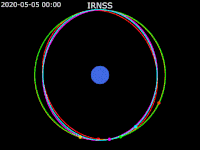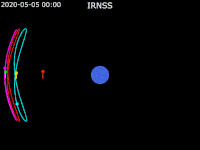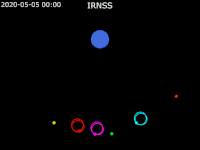IRNSS-1B
| Mission type | Navigation |
|---|---|
| Operator | ISRO |
| COSPAR ID | 2014-017A |
| SATCAT no. | 39635 |
| Website | http://www.isro.org/pslv-c24/mission.aspx |
| Mission duration | 10 years |
| Spacecraft properties | |
| Bus | I-1K |
| Manufacturer | ISRO Satellite Centre Space Applications Centre |
| Launch mass | 1,432 kilograms (3,157 lb) |
| Power | 1,660 watts |
| Start of mission | |
| Launch date | 4 April 2014, 11:44 UTC |
| Rocket | PSLV-XL C24 |
| Launch site | Satish Dhawan FLP |
| Contractor | ISRO |
| Orbital parameters | |
| Reference system | Geocentric |
| Regime | Geosynchronous |
| Longitude | 55° East |
| Perigee altitude | 35,714 km (22,192 mi)[1] |
| Apogee altitude | 35,870 km (22,290 mi)[1] |
| Inclination | 30.57 degrees[1] |
| Period | 1436.010 minutes[1] |
| Epoch | 25 January 2015, 01:32:48 UTC[1] |
IRNSS-1B is the second out of seven in the Indian Regional Navigation Satellite System (IRNSS) series of satellites after IRNSS-1A.[2] The IRNSS constellation of satellites is slated to be launched to provide navigational services to the region. It was placed in geosynchronous orbit on 4 April 2014.[3][4]
Satellite[edit]
The satellite will help augmenting the satellite based navigation system of India which is currently under development. The navigational system so developed will be a regional one targeted towards South Asia. The satellite will provide navigation, tracking and mapping services.[5]
IRNSS-1B satellite has two payloads: a navigation payload and CDMA ranging payload in addition with a laser retro-reflector. The payload generates navigation signals at L5 and S-band. The design of the payload makes the IRNSS system interoperable and compatible with Global Positioning System (GPS) and Galileo.[3] The satellite is powered by two solar arrays, which generate power up to 1,660 watts, and has a life-time of ten years.
Launch[edit]
The 1,432 kg satellite was launched on 4 April 2014 at 11:44 UTC (17:14 IST) aboard the PSLV-C24 rocket from Satish Dhawan Space Centre, Sriharikota.[4]
See also[edit]
- Communication-Centric Intelligence Satellite (CCI-Sat)
- GPS-aided geo-augmented navigation (GAGAN)
- Satellite navigation
- 2014 in spaceflight
References[edit]
- ↑ 1.0 1.1 1.2 1.3 1.4 "IRNSS 1B Satellite details 2014-017A NORAD 39635". N2YO. 25 January 2015. Retrieved 25 January 2015.
- ↑ "IRNSS-1B". Indian Space Research Organisation. Retrieved 4 April 2014.
- ↑ 3.0 3.1 "IRNSS". space.skyrocket.de. Retrieved 6 December 2014.
- ↑ 4.0 4.1 "ISRO puts India's Navigation satellite IRNSS 1B into orbit". IANS. news.biharprabha.com. Retrieved 4 April 2014.
- ↑ "ISRO: After GSLV launch, PSLV C24 with IRNSS-1B likely in March". India TV News. 5 January 2014. Retrieved 6 January 2014.





